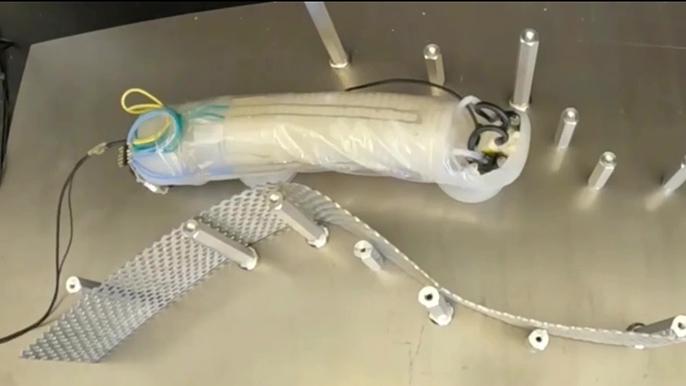GE Develops Worm-Inspired Robot For On-Wing Engine Inspections

Engine OEMs have recently developed multiple unique inspection robots resembling various creatures, including snakes and beetles, that can travel inside engines to hunt for defects. Now, GE Aerospace has developed an even more flexible, animal-inspired robot that it hopes will inch its way toward more optimized on-wing jet engine inspections.
Resembling an inchworm, the Sensiworm (Soft ElectroNics Skin-Innervated Robotic Worm) uses untethered soft robotics technology to move easily through the nooks, crannies and curves of jet engine parts to detect defects and corrosion. The robot is also able to measure the thickness of an engine’s thermal barrier coatings.
Developed in partnership with SEMI Flex Tech, Binghamton University and UES, Inc., Sensiworm is controlled by an operator using a device that GE says is similar to a gaming controller and can be programmed to follow specific paths. “It has a sticky, suction-like bottom that enables it to climb and adhere to steep surfaces. Also, because the robot is very soft and compliant, it won’t harm any surfaces or cause any damage during an inspection,” says a spokesperson for GE.
Video credit: GE Aerospace
“With mini-robot companions like Sensiworm, service operators would have multiple additional sets of eyes and ears to perform on-wing inspections,” says Deepak Trivedi, principal robotics engineer at GE Aerospace Research. “With their soft, compliant design, they could inspect every inch of [a] jet engine, transmitting live video and real-time data about the condition of parts that operators typically check.”
Traditionally, these types of inspections are performed using advanced inspection tools such as video borescopes. However, GE says this technology is limited due to factors such as gravity, which can cause the borescope’s tip to naturally settle when not braced against a structure within the engine. The robot can also be deployed through the turbine inlet or exhaust of an engine, which GE says provides coverage of a much larger swath of the turbine that would otherwise be missed using borescopes and other previously developed robotic platforms, which use conventional port access points. GE notes that it sees Sensiworm as a complementary tool to be used in conjunction with these other methods of inspection.

According to GE, Sensiworm could reduce unnecessary engine removals and downtime, enabling faster turnarounds. Although Sensiworm is currently focused on engine inspections, Trivedi says the OEM is developing new capabilities that would enable the robot to execute repairs once it finds a defect.
Sensiworm has been under development for three years, but GE notes that the technology is still in the early stages of development. “We’re still a few years away from the prospect of deploying these types of robots widely in the field,” says GE’s spokesperson.
GE Aerospace has been heavily involved in exploring the deployment of robotics for MRO. It acquired UK-based OC Robotics in 2017 and has been developing snake-arm robotics technologies to help automate cleaning, inspection and repair of engines. GE is also developing artificial intelligence applications for engine inspections in partnership with Waygate Technologies.





